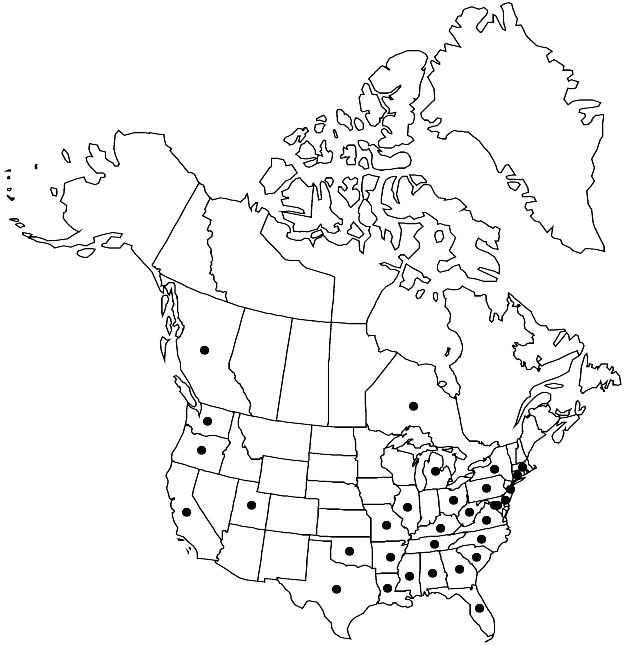Difference between revisions of "Cardamine hirsuta"
Sp. Pl. 2: 655. 1753.
FNA>Volume Importer |
FNA>Volume Importer |
||
| Line 23: | Line 23: | ||
|elevation=0-700 m | |elevation=0-700 m | ||
|distribution=B.C.;Ont.;Ala.;Ark.;Calif.;Conn.;Del.;D.C.;Fla.;Ga.;Ill.;Ky.;La.;Md.;Mass.;Mich.;Miss.;Mo.;N.J.;N.Y.;N.C.;Ohio;Okla.;Oreg.;Pa.;S.C.;Tenn.;Tex.;Utah;Va.;Wash.;W.Va.;w Eurasia;introduced also in Central America;South America;e Asia (Japan);South Africa;Australia. | |distribution=B.C.;Ont.;Ala.;Ark.;Calif.;Conn.;Del.;D.C.;Fla.;Ga.;Ill.;Ky.;La.;Md.;Mass.;Mich.;Miss.;Mo.;N.J.;N.Y.;N.C.;Ohio;Okla.;Oreg.;Pa.;S.C.;Tenn.;Tex.;Utah;Va.;Wash.;W.Va.;w Eurasia;introduced also in Central America;South America;e Asia (Japan);South Africa;Australia. | ||
| − | |discussion=<p>Herbarium specimens of Cardamine hirsuta have been misidentified as C. oligosperma.</p> | + | |discussion=<p>Herbarium specimens of <i>Cardamine hirsuta</i> have been misidentified as <i>C. oligosperma</i>.</p> |
|tables= | |tables= | ||
|references= | |references= | ||
| Line 48: | Line 48: | ||
|publication year=1753 | |publication year=1753 | ||
|special status= | |special status= | ||
| − | |source xml=https://jpend@bitbucket.org/aafc-mbb/fna-data-curation.git/src/ | + | |source xml=https://jpend@bitbucket.org/aafc-mbb/fna-data-curation.git/src/8f726806613d60c220dc4493de13607dd3150896/coarse_grained_fna_xml/V7/V7_727.xml |
|tribe=Brassicaceae tribe Cardamineae | |tribe=Brassicaceae tribe Cardamineae | ||
|genus=Cardamine | |genus=Cardamine | ||
Revision as of 17:59, 18 September 2019
Annuals; sparsely hirsute basally (at least on petiole of basal leaves), often glabrous distally. Rhizomes absent. Stems erect, ascending, or decumbent, unbranched or branched basally and/or distally, (0.3–)1–3.5(–4.5) dm, (not flexuous). Basal leaves (persistent to anthesis), rosulate, (5–)8–15(–22)-foliolate, (2–)3.5–15(–17) cm, leaflets petiolulate; petiole 0.5–5 cm, (ciliate); lateral leaflet blade oblong, ovate, obovate, or orbicular, smaller than terminal, margins entire, repand, crenate, or 3-lobed; terminal leaflet (petiolule 0.2–1 cm), blade reniform or orbicular, 0.4–2 cm × 6–30 mm, margins entire, repand, dentate, or 3 or 5-lobed. Cauline leaves 1–4(–6), compound as basal, petiolate, [(0.5–)1.2–5.5(–7) cm, including petiole], leaflets petiolulate; blade base not auriculate; leaflets similar to basal. Racemes ebracteate. Fruiting pedicels erect to ascending, (2–)3–10(–14) mm. Flowers: sepals oblong, 1.5–2.5 × 0.3–0.7 mm, lateral pair not saccate; petals (sometimes absent) white, spatulate, 2.5–4.5(–5) × 0.5–1.1 mm; (stamens usually 4, lateral pair often absent, rarely 5 or 6); filaments 1.8–3 mm; anthers ovate, 0.3–0.5 mm. Fruits linear, (torulose), (0.9–)1.5–2.5(–2.8) cm × (0.8–)1–1.4 mm, (often appressed to rachis); ovules 14–40 per ovary; style 0.1–0.6(–1) mm. Seeds light brown, oblong or subquadrate, 0.9–1.3(–1.5) × 0.6–0.9(–1.1) mm, (narrowly margined). 2n = 16.
Phenology: Flowering Feb–Jul.
Habitat: Roadsides, clearings, disturbed sites, slopes, cedar glades, mixed woods, meadows, fields, waste grounds, damp places, grassy areas
Elevation: 0-700 m
Distribution

B.C., Ont., Ala., Ark., Calif., Conn., Del., D.C., Fla., Ga., Ill., Ky., La., Md., Mass., Mich., Miss., Mo., N.J., N.Y., N.C., Ohio, Okla., Oreg., Pa., S.C., Tenn., Tex., Utah, Va., Wash., W.Va., w Eurasia, introduced also in Central America, South America, e Asia (Japan), South Africa, Australia.
Discussion
Herbarium specimens of Cardamine hirsuta have been misidentified as C. oligosperma.
Selected References
None.